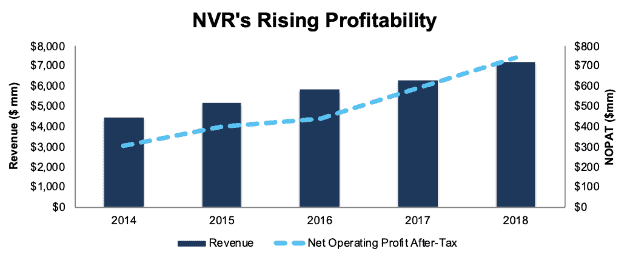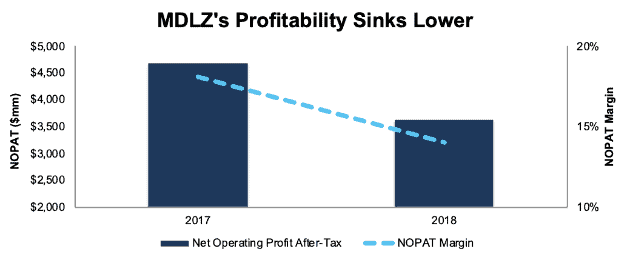31 new stocks make our Most Attractive list this month, and 23 new stocks fall onto the Most Dangerous list this month. March’s Most Attractive and Most Dangerous stocks were made available to members on March 6, 2019.
The successes of these model portfolios highlight the value of our machine learning and AI Robo-Analyst technology[1], which helps clients fulfill the fiduciary duty of care and make smarter investments[2].
Our Most Attractive stocks have high and rising returns on invested capital (ROIC) and low price to economic book value ratios. Most Dangerous stocks have misleading earnings and long growth appreciation periods implied by their market valuations.
Most Attractive Stocks Feature for March: NVR Inc. (NVR: $2,740/share)
NVR Inc. (NVR) is the featured stock from March’s Most Attractive Stocks Model Portfolio.
We made NVR a Long Idea on 4/17/17, and the stock has outperformed the S&P 500 since then (up 28% vs. S&P up 19%). As of March 2019, our NVR Long Idea has helped make us the #3 stock picker in Industrials per SumZero Rankings.
Since 2014, NVR has grown after-tax operating profit (NOPAT) by 25% compounded annually. Profit growth has been fueled by rising NOPAT margins, which are up from 7% in 2014 to 10% in 2018. NVR’s return on invested capital (ROIC) has also improved from 19% to 32% over the same time.
Figure 1: NVR’s Revenue & NOPAT Since 2014

Sources: New Constructs, LLC and company filings
NVR Valuation Provides Significant Upside
At its current price of $2,740/share, NVR has a price-to-economic book value (PEBV) ratio of 0.9. This ratio means the market expects NVR’s NOPAT to permanently decline by 10%. This expectation seems overly pessimistic for a firm that has grown NOPAT by 25% compounded annually over the past four years.
If NVR can maintain TTM NOPAT margins (10%) and grow NOPAT by just 3% compounded annually for the next decade, the stock is worth $3,778/share today – a 38% upside. See the math behind this dynamic DCF scenario.
Critical Details Found in Financial Filings by Our Robo-Analyst Technology
As investors focus more on fundamental research, research automation technology is needed to analyze all the critical financial details in financial filings. Below are specifics on the adjustments we make based on Robo-Analyst findings in NVR’s 2018 10-K:
Income Statement: we made $133 million of adjustments, with a net effect of removing $55 million in in non-operating income (<1% of revenue). You can see all the adjustments made to NVR’s income statement here.
Balance Sheet: we made $1.9 billion of adjustments to calculate invested capital with a net increase of $539 million. One of the largest adjustments was $396 million due to asset write-downs. This adjustment represented 22% of reported net assets. You can see all the adjustments made to NVR’s balance sheet here.
Valuation: we made $1.8 billion of adjustments with a net effect of decreasing shareholder value by $1.2 billion. The largest adjustment to shareholder value was $766 million in employee stock option (ESO) costs. This adjustment represents 8% of NVR’s market cap.
Most Dangerous Stocks Feature: Mondelez International (MDLZ: $48/share)
Mondelez International (MDLZ) is the featured stock for March’s Most Dangerous Stocks Model Portfolio. We put MDLZ in the Danger Zone in March 2016 and the stock remains overvalued.
MDLZ faces many of the same challenges that recently sunk Kraft Heinz (KHC). The company is losing market share, as evidenced by the 7% compounded annual decline in revenue over the past 4 years. MDLZ has been able to offset this revenue decline with cost-cutting in the past, but its issues came to a head in 2018, when NOPAT declined by 22% and NOPAT margin fell from 18% to 14% year-over-year.
Figure 2: MDLZ Falling Profits

Sources: New Constructs, LLC and company filings
MDLZ Provides Poor Risk/Reward
Despite the deterioration in fundamentals, MDLZ is up 19% so far in 2019, which has left shares significantly overvalued.
To justify its current price of $48/share, MDLZ must maintain its 2018 NOPAT margin (14%) and grow NOPAT by 8% compounded annually. See the math behind this dynamic DCF scenario. This expectation seems lofty given MDLZ’s recent NOPAT decline and stagnant profits since 2014.
If the company can maintain current NOPAT margins (14%) and grow NOPAT by 3% compounded annually for the next 10 years, the stock is worth just $33/share today – a 44% downside. See the math behind this dynamic DCF scenario.
Critical Details Found in Financial Filings by Our Robo-Analyst Technology
As investors focus more on fundamental research, research automation technology is needed to analyze all the critical financial details in financial filings. Below are specifics on the adjustments we make based on Robo-Analyst findings in MDLZ’s 2018 10-K:
Income Statement: we made 2.6 billion of adjustments, with a net effect of removing $251 million in non-operating expenses (<1% of revenue). You can see all the adjustments made to MDLZ’s income statement here.
Balance Sheet: we made $22.6 billion of adjustments to calculate invested capital with a net increase of $20.4 billion. One of the largest adjustments was $10.6 billion due to other comprehensive income. This adjustment represented 23% of reported net assets. You can see all the adjustments made to MDLZ’s balance sheet here.
Valuation: we made $25.4 billion of adjustments with a net effect of decreasing shareholder value by $24.2 billion. The largest adjustment to shareholder value was $3.3 billion in net deferred tax liabilities. This adjustment represents 5% of MDLZ’s market cap.
This article originally published on March 15, 2019.
Disclosure: David Trainer, Kyle Guske II, Sam McBride, and Andrew Gallagher receive no compensation to write about any specific stock, style, or theme.
Follow us on Twitter, Facebook, LinkedIn, and StockTwits for real-time alerts on all our research.
[1] Harvard Business School features the powerful impact of our research automation technology in the case New Constructs: Disrupting Fundamental Analysis with Robo-Analysts.
[2] Ernst & Young’s recent white paper “Getting ROIC Right” demonstrates the superiority of our stock research and analytics.
